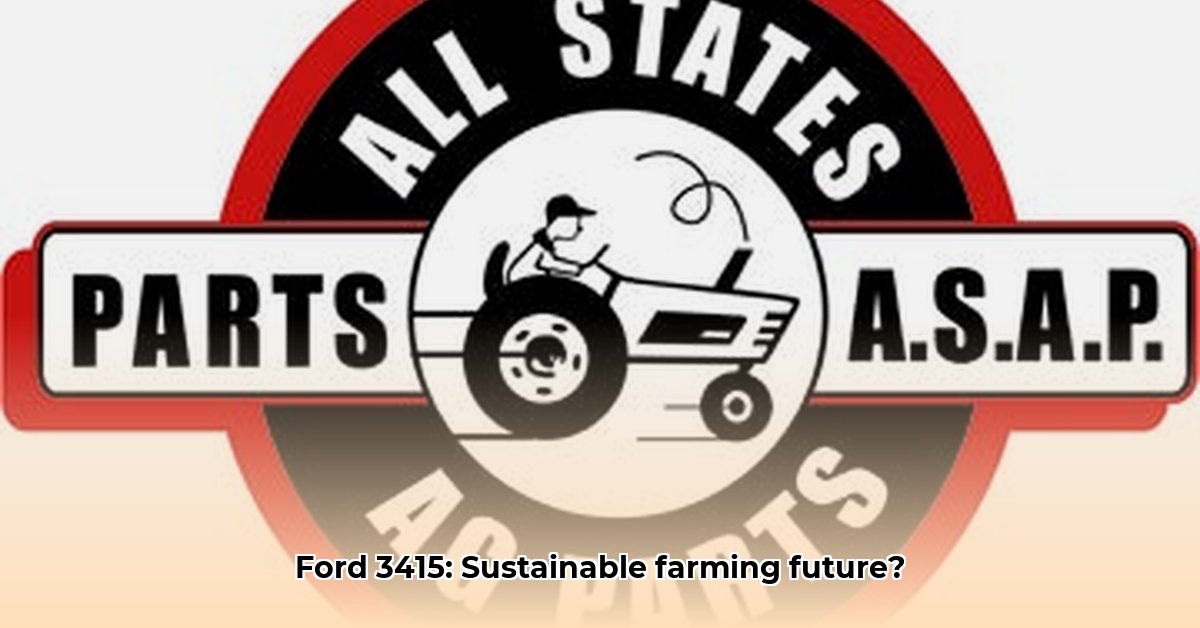
Is the Ford 3415 a Sustainable Choice for Modern Farming?
The Ford 3415 tractor, a compact utility model manufactured by Shibaura, presents a compelling case study in the complexities of sustainable agriculture. While its smaller size and relatively fuel-efficient diesel engine initially suggest environmental benefits, a deeper analysis reveals a more nuanced picture. This review examines the 3415's strengths and weaknesses, ultimately exploring whether it truly aligns with the goals of modern sustainable farming. For more on older Ford tractors, see this helpful resource on Ford tractor engines.
Size and Soil Health: A Gentle Footprint?
One undeniable advantage of the 3415 is its compact size and relatively light weight (approximately 4100 pounds). This lighter footprint minimizes soil compaction, a critical factor in maintaining soil health and long-term productivity. Healthy soil is the cornerstone of sustainable agriculture; less compaction means better water infiltration, improved aeration, and enhanced nutrient cycling. But does this benefit outweigh other considerations? Let's explore if this positive impact on soil health is enough to overcome other issues.
Fuel Efficiency and Emissions: A Balanced Look at Fuel Consumption
The 3415’s diesel engine offers better fuel economy than comparable gasoline tractors of its era. This translates to lower operating costs, an important factor for budget-conscious farmers. However, it lacks the advanced emission control technologies found in more modern tractors. This raises a crucial question: Does the reduced fuel consumption offset the potentially higher greenhouse gas emissions? We must weigh the immediate cost savings against the long-term environmental impact.
Technological Limitations: Bridging the Gap Between Old and New
Manufactured until 1999, the 3415 lacks the sophisticated technology prevalent in modern tractors. Features like GPS guidance, precision agriculture tools, and variable-rate application are absent. These technologies are crucial for optimizing resource use—a key element of sustainable farming. Can the 3415 effectively compete with modern advancements in efficiency, or does the lower purchase price come at the cost of increased workload and reduced efficiency? It's a critical question to consider.
Traction and Terrain: Two-Wheel Drive Considerations
The 3415 is a two-wheel-drive (2WD) tractor, limiting its traction, especially in challenging conditions. Reduced traction can lead to increased fuel consumption as the engine struggles, and potentially increased soil compaction as wheels slip. This could negate some of the positive impacts of its lighter weight. The trade-off between reduced soil compaction from its lighter weight and increased soil compaction from slippage needs to be carefully evaluated.
Weighing the Pros and Cons: A Summary Table
| Pros | Cons |
|---|---|
| Compact size; less soil compaction | Older technology; lacks modern precision agriculture tools |
| Relatively fuel-efficient diesel engine | Limited traction (2WD); potential for increased soil damage in wet conditions |
| Lower initial purchase cost | Higher potential for higher maintenance and repair costs |
| Simpler mechanics; easier potential repairs | Fewer available parts; longer repair times |
Is the Ford 3415 Truly Sustainable? A Critical Assessment
The long-term sustainability of the Ford 3415 depends on a holistic view of its entire lifecycle. While its lighter weight and relatively good (for its era) fuel economy represent immediate advantages, the lack of modern technology and increased potential repair costs must be factored in. A comprehensive cost-benefit analysis, considering fuel savings against repair costs and the environmental impact of increased emissions, is essential. Is the lower initial cost truly sustainable in the long run, both economically and environmentally?
Practical Steps for Maximizing the 3415's Potential
For farmers considering a Ford 3415, these steps are crucial:
- Thorough Pre-Purchase Inspection: A professional mechanic's inspection is vital to identify potential issues before purchase.
- Rigorous Preventative Maintenance: A detailed maintenance schedule will extend the tractor's lifespan and reduce downtime.
- Task Optimization: Match tasks to the 3415's capabilities to avoid strain and potential damage.
- Attachment Upgrades (where feasible): Explore compatible upgrades to improve efficiency and functionality.
The Ford 3415 represents a trade-off. It offers an affordable entry point for smaller-scale farmers, but its age and technological limitations pose challenges within the context of modern sustainable farming. The ultimate decision rests on individual needs, priorities, and farming practices. Careful consideration is absolutely crucial.
Comparing Ford 3415 Fuel Efficiency to Modern Tractors: A Challenging Task
Directly comparing the Ford 3415's fuel efficiency to modern tractors is difficult due to limited readily available data for the older model. While its lower horsepower suggests lower fuel consumption during lighter tasks, this is a simplification. Modern tractors incorporate fuel-saving technologies (engine management systems, improved transmissions, etc.) that greatly offset the initial seeming advantage of the 3415's lower horsepower. The difficulty in sourcing parts for the 3415 significantly impacts its long-term viability, and potentially its overall "fuel efficiency" over its lifetime due to downtime and ongoing repair costs. The combined effect of higher repair costs and fewer modern fuel-saving technologies makes the long-term sustainability of the Ford 3415 questionable compared to newer models.